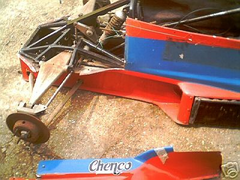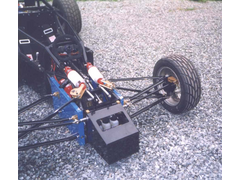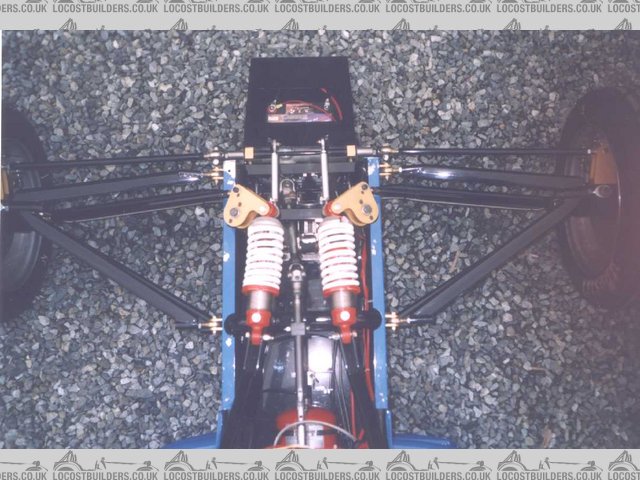F1 Mini
|
| posted on 7/5/04 at 06:57 PM |

|
|
Ackerman How do you measure it ?
There's not so much infomation in my books about Ackerman, I think it is measured as a line through the trackrod end and the top ball joint
(from a Plan View of the car) and where both the left and right lines meet should be at the centre of the rear axle line.
Is the correct, as I have been told if it's shorter then thats Negative ackerman and longer is Posative.
|
|
|
|
|
I love speed :-P
|
| posted on 7/5/04 at 07:09 PM |

|
|
try this
http://locostbuilders.co.uk/viewthread.php?tid=10716
Don't Steal
The Government doesn’t like the competition
|
|
|
britishtrident
|
| posted on 7/5/04 at 07:19 PM |

|
|
Drawing lines through balljoints only really works with steering system that have a centre track rod steering box and idler arm, with a steering rack
the akerman geometry is domminated by the fore aft position of the rack. And if you need any ackerman or anti-ackerman at all is another can of
worms.
|
|
|
Mark Allanson
|
| posted on 7/5/04 at 07:39 PM |

|
|
You only need true ackerman if you vehicle is pulled by a horse
If you can keep you head, whilst all others around you are losing theirs, you are not fully aware of the situation
|
|
|
F1 Mini
|
| posted on 7/5/04 at 08:27 PM |

|
|
quote:
Originally posted by Mark Allanson
You only need true ackerman if you vehicle is pulled by a horse
?????? are you on drugs ?
|
|
|
F1 Mini
|
| posted on 7/5/04 at 08:38 PM |

|
|
My problem is do you draw the line through the top ball joint ( and track rod end ) or the point at which a horizontal line from the Track rod end
meets the King pin centre line.
Basicaly why the top ball joint, why not the bottom ball joint ? See what I'm getting at, or do I just sounding nuts....
|
|
|
Mark Allanson
|
| posted on 7/5/04 at 08:42 PM |

|
|
quote:
?????? are you on drugs ?
There is not a single production car on the road today that uses true ackerman, unless its top design speed is less than 30mph
I believe electric milk floats use it
If you can keep you head, whilst all others around you are losing theirs, you are not fully aware of the situation
|
|
|
Mark Allanson
|
| posted on 7/5/04 at 08:45 PM |

|
|
If you really want to measure it, measure the toe out on turn angles, and bisect it back from the wheelbase, this will give you the turn raduis of
each front wheel
If you can keep you head, whilst all others around you are losing theirs, you are not fully aware of the situation
|
|
|
britishtrident
|
| posted on 7/5/04 at 08:52 PM |

|
|
Ackerman sterring geometry isn't a good idea, racing cars tend to used either parrallel or some toe-in in turns (anti ackerman) all to do
with tyre loading and the relationship between tyre loading and maxium slip angle.
[Edited on 7/5/04 by britishtrident]
|
|
|
Mark Allanson
|
| posted on 7/5/04 at 08:56 PM |

|
|
I didn't know about the tyre loading aspect, but anything with a true ackerman, is VERY unstable at even moderate speeds in a straight line -
still not sure why F1mini thought I might be on drugs!
If you can keep you head, whilst all others around you are losing theirs, you are not fully aware of the situation
|
|
|
F1 Mini
|
| posted on 7/5/04 at 09:18 PM |

|
|
Sorry didn't mean to offened thought it was a funny... So ackerman is not worth worrying about, or are you saying not true ackerman but more
ackerman or less ?
I do need help to see weather it is worth me changing what I have at present.
With a standard Mini wheels base of 80" I presently have a 71" converging point (that is if it is the top ball joint you use).
On a more serious note, the GTD40 owners club have pin pointed that there Ackerman lenght was at the engine bulk-head. A bit to short so they altered
there steering arms and managed 2 Seconds faster around Goodwood race track. So it make me think what do I need ?
Confused..... I am alittle...
|
|
|
Mark Allanson
|
| posted on 7/5/04 at 09:24 PM |

|
|
I suppose being technical, the point to use should be where the kingpin line is bisected along the spindle height.
I would have thought the convergance point should be behind the rear axle, parallel would be at infinity
If you can keep you head, whilst all others around you are losing theirs, you are not fully aware of the situation
|
|
|
F1 Mini
|
 posted on 7/5/04 at 09:26 PM posted on 7/5/04 at 09:26 PM |

|
|
Sorry again, my sense of Humor. Life's normaly to short not to fool around, and have a laugh.
Yes I am new to this forum, but am realy glad to have found it... Must remember to attach (    ) when making a Joke.... ) when making a Joke....
|
|
|
Mark Allanson
|
| posted on 7/5/04 at 09:34 PM |

|
|
 Point taken, we do sometimes get over engrosed in the technicallities! Point taken, we do sometimes get over engrosed in the technicallities!
If you can keep you head, whilst all others around you are losing theirs, you are not fully aware of the situation
|
|
|
Mark Allanson
|
| posted on 7/5/04 at 09:36 PM |

|
|
http://www.locostbuilders.co.uk/viewthread.php?tid=7012
[Edited on 7/5/04 by Mark Allanson]
If you can keep you head, whilst all others around you are losing theirs, you are not fully aware of the situation
|
|
|
Mark Allanson
|
| posted on 7/5/04 at 10:09 PM |

|
|
I was told about the high speed stability thing on my C&G course, I just took it as gospel, but thinking about it, if there is no movement in the
suspension, how would it know!
If you can keep you head, whilst all others around you are losing theirs, you are not fully aware of the situation
|
|
|
britishtrident
|
| posted on 8/5/04 at 07:37 AM |

|
|
For ackerman 101 just watch an episode of the Rockford files --- most Yank tanks of this period had (almost) true ackerman geometry, watch the
inside front tyres squealing uselessly in the car chase scenes.
To generate cornering force tyres must run at an angle to the true tangent the the circle vehicle is following this difference is called the slip
angle. Because of the nature of a tyres friction characteristic the more highly loaded outside tyre generates its maximum cornering power at a
greater slip angle than the lightly loaded inside tyre.
For this reason over about 10 mph true ackerman steering geometry would over load the inside fron tyre causing it to generate little or no cornering
force -- the Rockford files syndrome.
Cars with rack and pinnions cannot have true ackerman geometry anyway -- it is impossible the geometry is dictated by the position of the rack. It
can does however have a quasi ackerman effect, on the book Locost setup move the rack backwards you get more ackerman backwards less, on a Cortina or
Sierra front end the steering arms have little or nothing to do with it.
At the end 1950s after studying tyre data Colin Chapman adopted a lot of anti-ackerman on the Seven S1 and other Loti racers of the period such as the
18. It did give some increase in cornering power but drivers found made the car twitchy and unstable at high speed.
With the Seven S2 Chapman went to rack and pinnion steering and at the same time the anti-ackerman was removed replaced by a small degree of
quasi-ackerman as used on the other Lotus roads cars of the period.
This now standard practice on rwd cars. Shopping cars like the Cortina and RWD Escort used quite at lot of this quasi-ackerman the steering rack
being mounted a few inches behind the track rod end centrelines. While in the race car world on a typical Formula Ford the steering rack would be
postioned nearly in line with the track rod ends to give some quasi-ackerman at small angles of steering changing to anti-ackerman as you
approach full lock.
With the book Locost I suspect any ackerman angle would be swamped by the large ammounts of bump/roll steer.
[Edited on 8/5/04 by britishtrident]
[Edited on 8/5/04 by britishtrident]
|
|
|
NS Dev
|
| posted on 8/5/04 at 08:48 AM |

|
|
Hmmm, I am no expert here but would agree with Syd and his points.
On my grasser which runs a very short wheelbase, I altered the cortina uprights to gain more steering lock per mm movement of the rack (now have 0.9
turns lock to lock) but also to move the trackrod to steering arm attachment points outwards (as you mentioned F1 Mini) to give more ackerman angle
(well, to get the inside wheel to turn tighter than the outside one, I don't really give a crap what this is called but it has to happen for the
car to steer properly!!!!)
I have read several articles in CCC magazine where the tech ed Dave Walker (of Emerald fame not Newark Engines!) has talked about needing to move the
trackrod to steering arm attachment points outwards to give a better approximation to ackerman geometry in order to REDUCE understeer (totally the
opposite to what BritishTrident says).
All I know is I have a lot of ackerman (Mike R saw it in the car!) and it turns in on a dirt track really well (probably better than any of the other
cars in my class) but before I changed the ackerman it was a real understeerer! (and this is noticeable on a dirt surface!)
Back to the original point of measuring it, I don't know a particularly sciantific way. I just make things adjustable, then adjust them and see
what goes quickest! Not terribly scientific I know but it works (and the sciance behind the adjustments usually becomes obvious afterwards!)
|
|
|
britishtrident
|
| posted on 8/5/04 at 09:07 AM |

|
|
Study this image carefully it is of a Van Diemen FF chassis -- Van Diemen were the builder with the longest run of success in this class spanning
decades.
Formula Ford is the class with suspension demands quite close to a the demands of a Locost style car.
Can anyone one spot any ackerman or quasi ackerman ? infact it has a tiny ammount of quasi ackerman.
http://cgi.ebay.co.uk/ws/eBayISAPI.dll?ViewItem&category=9883&item=2477033370&rd=1&ssPageName=WDVW
[Edited on 8/5/04 by britishtrident]
 
Rescued attachment 49_1_s.JPG
|
|
|
britishtrident
|
| posted on 8/5/04 at 09:20 AM |

|
|
Another couple of Formula Ford picture
This time showing car with a bit of anti-ackerman --- toe-in in turns.
[Edited on 8/5/04 by britishtrident]
 
Rescued attachment foxfrontcornerbarelrg.jpg
|
|
|
britishtrident
|
| posted on 8/5/04 at 09:26 AM |

|
|
Plan view QED
[Edited on 8/5/04 by britishtrident]
 
Rescued attachment foxtopfrontshockslrg.jpg
|
|
|
NS Dev
|
| posted on 8/5/04 at 11:00 AM |

|
|
Yes Syd, if I read you correctly, in saying that the trackrods mount outboard of the top balljoint (and one assumes, unless the geometry is very
strange, the lower balljoint too) you are quite right.
I modified my cortina uprights to suit a short wheelbase by moving the connection on the steering arm out my around 8mm, this gave increased ackerman
which seemed to work well.
Certainly the steering arm connection points on the last photo above would give some degree of ackerman steering angle.
|
|
|
WIMMERA
|
| posted on 8/5/04 at 01:07 PM |

|
|
A series of articles written by Staniforth appeared in Race Tech magazine #31-#35 which covers the subject in detail ,including rack mounting , very
interesting read , but in short it came down very much in favour of Ackermann and plenty of it, to the point where the converging lines through
TRE's and KPI line meet between the drives legs
|
|
|
JoelP
|
| posted on 8/5/04 at 07:10 PM |

|
|
to my thinking, ackerman related specifically to the line between the hub pivot and the steering rod end. if a pair of hydralic pistons were used (as
opposed to a rack where to knuckles move) then ackerman geometry would be simple. moving the rack forward and back undoubtedly has a significant
effect on the steering geometry, but i previously wouldnt have counted this as ackerman effect/geometry. would i be wrong? did ackermans thinking go
beyond just the hub design?
personally i think it would be good to use a pair of hydralic pistons to move the wheels, then the geometry wouldnt change so much from lock to lock.
it seems to me that when you take into account the steering rack knuckles moving it becomes a case of 'best fit' rather than complete
control. unless it is advantageous to have a nonlinear relationship between steering wheel movement and degrees of either wheel movement.
|
|
|
F1 Mini
|
| posted on 8/5/04 at 08:45 PM |

|
|
quote:
Originally posted by WIMMERA
A series of articles written by Staniforth appeared in Race Tech magazine #31-#35 which covers the subject in detail ,including rack mounting , very
interesting read , but in short it came down very much in favour of Ackermann and plenty of it, to the point where the converging lines through
TRE's and KPI line meet between the drives legs
Sorry Bud what's a Drive Leg ? Term I've not herd before.
|
|
|













